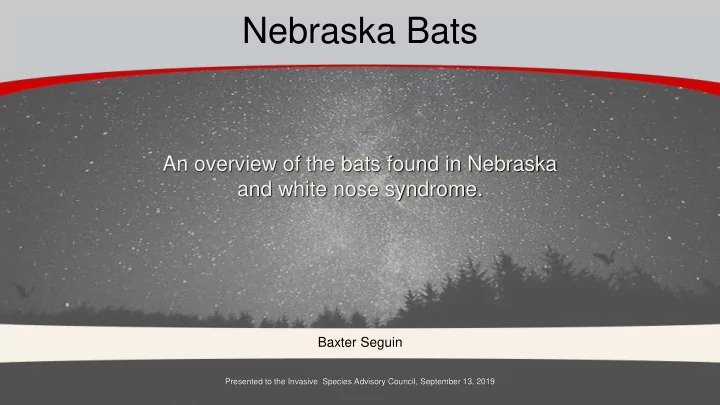

Nebraska Bats An overview of the bats found in Nebraska and white nose syndrome. Baxter Seguin Presented to the Invasive Species Advisory Council, September 13, 2019
Why Bats?
Ecosystem Services Pollination – Cactus flowers in the Southwest – Agave (tequila) – Mangoes – Bananas – Guavas – Over 300 species of plants Lesser long nosed bat
Ecosystem Services Guano – The War of the Pacific – “Guano War” – 1879 – Bolivia and Peru vs. Chile – Nitrogen rich fertilizer
Ecosystem Services Insectivores • 70% of bat species worldwide eat insects • These bats can eat 125% of their weight each night
Ecosystem Services Insectivores • 70% of bat species worldwide eat insects • These bats can eat 125% of their weight each night • Without bats... • Corn costs could increase 20-30% • Cotton costs could increase 10-13%
Value of Bats Bats contribute >$3.7 Billion per year to reducing crop loss and pesticide use in the US alone ( source: Boyles, et al, 1 APRIL 2011 VOL 332 SCIENCE www.sciencemag.org)
Value of Bats Extent Crop Amount Source (Wanger, Darras, Thailand Rice $1.2 million Bumrungsri, Tscharntke, & Klein, 2014) (Brown et al., 2015) Globally Corn $1 billion (Cleveland et al., Texas (8 counties) Cotton $741,000 2006) (Boyles et al., 2011) North America All crops $3.7-53 billion
Bat Species of Nebraska Duram photos
Bat Species of Nebraska Hoary Bat 15.5 inches Big Brown Bat 12.9 inches Northern Long-eared Bat 10 inches Tri-colored Bat 9.25 inches
Big Brown Bat Eptesicus fuscus • Wingspan: 12.5 inches • Diet: Moths and beetles • Winter: Hibernate in caves and buildings
Eastern Red Bat Lasiurus borealis • Wingspan: 12.2 inches • Diet: Moths, beetles, and flies • Winter: Migrate and tree roost Duram photos
Silver Haired Bat Lasionycteris noctivagans • Wingspan: 11.5 inches • Diet: Moths, flies, leafhoppers, and beetles • Winter: Short distance migrants Duram photos
Hoary Bat Lasiurus cinereus • Wingspan: 15.5 inches • Diet: Moths • Winter: Migrate and tree roost Duram photos
Northern long-eared Bat Myotis septentrionalis • Wingspan: 10 inches • Diet: Moths, crickets, spiders, stone flies • Winter: Hibernate in caves
Little Brown Bat Myotis lucifugus • Wingspan: 8-11 inches • Diet: Moths, mosquitoes, midges, mayflies... • Winter: Hibernate in buildings, caves, mines
Tri-colored Bat Perimyotis subflavus • Wingspan: 9 inches • Diet: Opportunistic • Winter: Hibernate in caves and mines Duram photos
Western Small-footed Myotis Myotis ciliolabrum • Wingspan: 9.4 inches • Diet: Moths, beetles, and flies • Winter: Hibernate in caves and cliffs
Fringed Myotis Myotis thysanodes • Wingspan: 11 inches • Diet: Beetles and moths • Winter: Hibernate in buildings and mines
White Nose Syndrome
White Nose Syndrome Pseudogymnoascus destructans Or Pd
White Nose Syndrome
White Nose Syndrome
White Nose Syndrome >90% mortality in cave dwelling species
White Nose Syndrome Long lived Low reproduction rates longer Lifespan shorter smaller bigger Body weight
White Nose Syndrome Quick animation showing the spread since 2006
Species Affected in NE Tri-colored bat (Peryimyotis subflavus) Little brown bat (Myotis lucifugus) Northern long-eared bat (Myotis septentrionalis)
White Nose Syndrome So that is the bad news… What can we do about it?
White Nose Syndrome Anti fungal bacterium Originally studied to combat fruit spoiling
White Nose Syndrome Avoid further spread Decontamination
WNS in Nebraska Habitat Habitat Habitat!
How can the public help?
Primum non nocere You don’t have to actively try to help bats to do good... ...just avoid doing additional harm
Timing tree clearing • Cut between Oct. and March 15 • Avoid removing snags if possible
Exclusion efforts • Avoid excluding during summer months • Use reputable exclusion experts • Install bat houses well in advance
Avoid Entering Caves • White-nose syndrome is easily spread cave-to-cave • Avoid recreational caving • If you have been in an eastern cave, avoid western caves! Tim Carter
Help out the bats You can also do things to help out bats!
Bat Houses • 60 % occupied within 2 years •Tall designs (>25”) are best • Bats like it hot! • Avoid trees • Keep out wasps • No spraying! •Use BCI’s plans
Stock Tank Ladders • Many animals drown in stock tanks including bats. • Ladders help provide an exit. • Costs: $45-60/8 ladders • Required at NRCS watering facilities Journal Star
Bat Friendly Gardens • Bats need food, water, and shelter. • Plants to attract moths • Water features • Maintain roost structures or bat houses. Journal Star
Spread the word! • Get the word out about bats! • Citizen Science • Join or donate to bat conservation groups • Attend bat viewings • BioBlitz • Batcon.org • Batconservation.org
How do we Study Bats?
Studying Bats: Caves
Studying Bats: Mist Netting
Studying Bats: Telemetry
Studying Bats: Acoustics
North American Bat Monitoring Program (NABat)
Nebraska NABat
Nebraska NABat Stationary Detector Car Driving Deployments Transects
Nebraska NABat Work with over 100 private landowners Help from dozens of volunteers
Nebraska NABat Work with over 100 private landowners Help from dozens of volunteers 4 Years of successful data collection 2 More years of funding
Nebraska NABat
Nebraska NABat Establish an early warning system for common species decline
Nebraska NABat Establish an early warning system for common species decline Determine what landscape characteristics influence higher levels of bat activity for each species
Nebraska NABat Establish an early warning system for common species decline Determine what landscape characteristics influence higher levels of bat activity for each species Increase public awareness and involvement in bat research
Questions Baxter Seguin Baxter.seguin@gmail.com
Recommend
More recommend